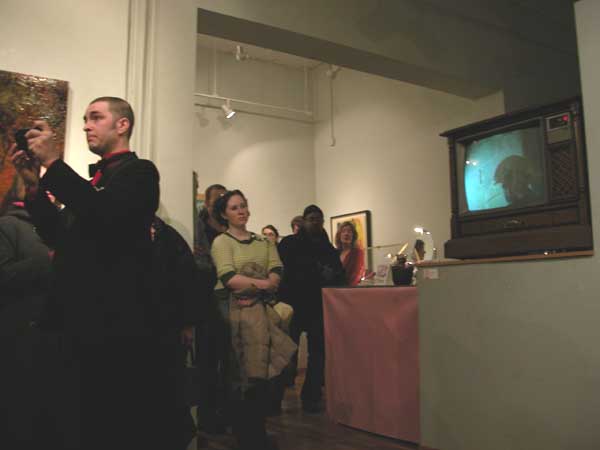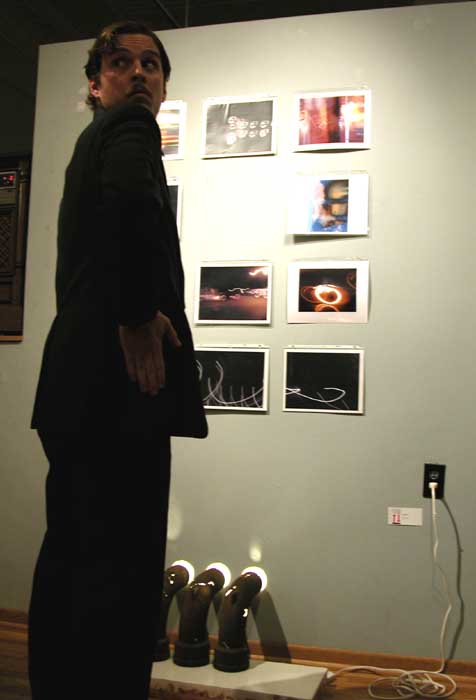“Secret Movie”: Ephemeral Critique
Chris Godsey reports back from an opening, a performance, a collection of art, a film, all in the same place, fitting into each other like a telescoping drinking glass.


Friday night. A storefront gallery on the south end of Uptown—it was once the lobby of the Calhoun Hotel. An opening (sort of). Outside, cigarette smokers and their section of sidewalk glow softly with light that drifts through the old lobby’s front window.
Just inside, a deeply tanned white guy with spiked and highlighted dirty blond hair is aggressively strumming an acoustic guitar and singing along. He’s adamant about his words, though they’re lost in the background cacophony of animated conversations and exaggerated greetings and general milling about in a long, narrow, tightly packed room with high ceilings and hardwood floors. If you knew a lot of these people and this scene, you’d be having a blast.
Striking, white alpha-women—mostly working a tasteful uniform of pointy-toed heels, low-rise jeans, long coats, and indifference—clutch little purses and circulate through the L-shaped space in twos and threes. Even if they know you’re trying to get by, even if you nicely say, “Excuse me,” or “Could I sneak behind you real quick?” they probably won’t acknowledge you, they definitely won’t move, and they might even look at their gorgeous sisters with incredulity: “Are you serious?!” They’re not the only people here, but they look and act like they’re the most important. They’re graceful snobs and impossibly attractive.
It’s the artist reception for The Mayor of Uptown–a Central Air production, curated by John Page Corrigan, that opened Feb. 10 and closes Feb. 26. According to a press release, The Mayor of Uptown is “a brief showing of exceptionally diverse and astute visual artists. From flower arrangements, lighting design, furniture, jewelry, performance art, the medium [sic] of paint and collage, and through photographic allure.”
That’s a good description of what’s on the walls—and the ceiling, and the floor—this evening. Some of the work stands out:
Just after nine o’clock, a 10-foot arc was cleared around a TV pushed up against the room’s back wall. A moment or two later, after some shushing, a man’s voice from somewhere in the crowd said, “Thank you all for coming to the show, and I’d like to formally announce that without further ado, Flaneur Productions is now putting on The Secret Movie.
Brief hubub ensued—you know how people are—then, from a room behind the TV, came the raised voice of Flaneur Jim Bovino: “You still don’t understand! This is a secret movie. A secret production. The whole city is part of a continuous story being told over and over for someone’s overwhelming entertainment.”
What followed was a 10-minute performance piece in which Bovino and fellow Flaneur Don Mabley-Allen play some sort of dim, obsequious middle managers in the piece’s eponymous cinematic process.
“Look over there,” Bovino proclaimed once they emerged from behind the wall and were standing in front of the TV on the open floor. He was in a black tuxedo, red shirt, and black bow tie; his vocal delivery matched his dress: faux-classy carnival barker. “The new shopping district–isn’t it beautiful? It’s like no other, I’m sure.” Mabley-Allen wore a suit and a bow tie of his own.
Bovino continued: “This city is the only place on earth. Each brick, each window, each doorknob and light fixture is perfect. It’s perfectly placed for the ultimate effect. The ultimate clarity of purpose of the director. I’m honored–humbled, really–at the trust of the good faith of the director. I mean, we’re all part of this grand conceit, this homage.… The deliberate arrangement of properties and light that fill us with these feelings.”
They’re confused about they should be doing, and they wind up taking orders from a shadowy, authoritative face that pops up on the TV. They ask the face if he’s the director of the movie; they get no answer.
“This is all a scene,” the TV says at one point. “Accepted, Believed in. What a perfect scenario, really. What an ideal entertainment. The sands quietly sift and the mask trips along. It’s a delight to see your dreams projected into the streets of the city. Who doesn’t—tell me—who doesn’t want to see their dreams over and over and over again?”
Later he says, “Inside we’re all brothers. Inside we all live in this city of ideal purpose. Nothing’s real beyond the lens. Nothing matters. Nothing remains in the memory that isn’t captured, solidified, by the caring considerations of this arch driver. This feels so real, doesn’t it? What’s outside the movie?”
“Nothing that matters,” says Bovino’s character.
“Did it ever?” continues the TV. “How can anything be certain unless it’s been preserved in film?”
Moments later, the piece concludes as the TV says, “This is the most significant moment of both of your lives. You’ve never been in a movie before, never known what’s it like to live as they do. Now you will. Now you see this whole thing—the city, one big movie, one big Fantasia. You’ll never be the same.”
A release announcing The Secret Movie says it’s based in “social critique examining the connection between the ideologically aestheticized cityscape, or collective relationship with the cult of celebrity and the movie industry and its effect on the possibility of autonomous behavior.”
Say what? What’s the “Ideologically aestheticized cityscape”?
“Block E,” Bovino said Thursday over coffee at Moose and Sadie’s, in the Warehouse District. “It’s the way there’s a fragmented feel in our urban community—how we create so-called ‘public spaces’ that are based on controlling people and how they spend their money. It’s faux nostalgia, faux urbanity, this created idea of a city that’s all about emotional manipulation…. We’re surrounded by a technosphere with particular interests. There is no objective reality.”
The piece “may or may not succeed,” he said. “It’s one gesture. It’s one point I’m trying to make…. I’m definitely interested more in poetics than polemics.”
As brief performance art—as fleeting aural and visual expression of the artists’ reactions to their environment—The Secret Movie did succeed. Its combination of abstract and obvious, challenging and accessible, was effective for an audience that wouldn’t have stayed captive for long (what with all the artistic, alcoholic, and social stimulation to be had).
Its major weakness was its medium. Paintings can be stared at. Recordings can be re-played at will. Words can be read and mulled in perpetuity. But ten-minute performance art is gone by the time it’s just getting started, and while The Secret Movie’s audience will remember seeing it, odds are they woke up Saturday morning without much recollection of what it said. Immediately after the piece was over, the gallery goers went back to their noisy ebb and flow, existing for the moment, engaged in ephemeral performances of their own.